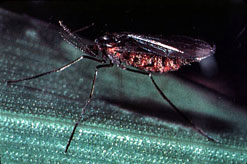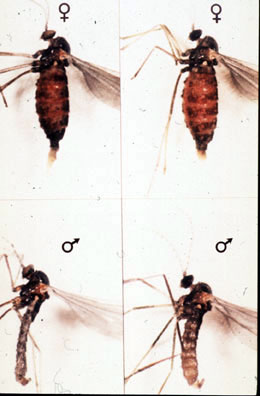 |
| Female Hessian fly on wheat leaf. Females of these members of the gall-forming midges lay eggs on wheat seedlings and cause stunting. Heavy infestations of larvae can kill the plant. |
The goal of research in our laboratory is to obtain basic information that will expand the use of genetic resistance for control of insect pests of wheat. The primary focus of the laboratory is on the molecular basis of Hessian fly/wheat interaction. The laboratory is located within the Crop Production and Pest Control Research Unit of the USDA-Agricultural Research Service, on the Purdue University campus in West Lafayette, Indiana. The research is a component of a CRIS project on Hessian fly Resistance in Wheat.
The Hessian fly is the main insect pest of wheat in the United States. Damage to wheat from the insect was estimated in 1989 in Georgia at $28 million. Historically, the Hessian fly has demonstrated the ability to eliminate wheat production. The primary method of control is through genetically resistant wheat. However, resistance resources in wheat and wheat relatives are expected to be finite. Knowledge of how the insect overcomes resistance in wheat is essential to continued control with genetic resources from wheat. Molecular markers for analysis of the genetic structure of field populations of the insect, an understanding of the molecular interaction between the insect and wheat, and identification of genes for resistance from alien sources to transform into wheat will be important for continued effective and durable control of the Hessian fly.
Current research projects in the laboratory include:
- Genetic mapping of genes controlling virulence in the Hessian fly to resistance in wheat. Approaches include identifying heritable DNA polymorphisms among purebreeding biotypes that cosegregate with alleles controlling virulence, determining the cytological location of cloned Hessian fly genomic sequences on salivary polytene chromosomes through in situ hybridization, and development of a saturated map for regions of the genome containing avirulence/virulence alleles.
- Analysis of transposition and insertions of a mariner transposable element from the Hessian fly. We are using in vitro analysis of transposition to investigate biological activity and putative recognition sequences in transposition and insertion of a mariner element in Hessian fly. Data from in vitro analyses will be applied to transposition in vivo and development of a transformation system.
- Transformation of wheat with genes from alien sources for resistance to Hessian fly and other insect pests. The recent ability to transform wheat with reasonable efficiency makes the use of transgenes to increase insect resistance feasible. We propose to identify genes for Hessian fly control to insert (transform) into wheat.
LAB PERSONNEL
Principal Investigator
Richard H. Shukle
Research Entomologist |
Support scientist
Virginia W. Russell
Molecular Biologist |
Doctoral student
Lubaki Zantoko
Graduate student - Purdue University |
|
RECENT RESULTS
We have demonstrated that in situ hybridization of cloned Hessian fly DNA sequences to salivary polytene chromosomes (Figures 1 and 2) can be used for development of a DNA-based genetic map. Genetic analyses have indicated that virulence in the Hessian fly to resistance gene H13 in wheat is linked to the morphological trait white eye (Figure 3). DNA markers linked to white eye have been identified. One of these DNA markers has been cloned, sequenced, and physically positioned by in situ hybridization near the end of the long arm of sex chromosome X1. This suggest the gene controlling white eye and the gene controlling virulence to H13 are also on the long arm of sex chromosome X1. Genetic mapping and molecular characterization of regions of the genome containing virulence genes will allow positional cloning of avirulence/virulence alleles, and subsequent determination of their mode of action. This will provide knowledge at the molecular level of how the insect overcomes resistance in wheat.
 |
 |
| Figure 1. Dissected alimentary tract and salivary glands of an Hessian fly larva. Salivary glands are the long filamentous structures going up. Large basal cells of the glands contain polytene chromosomes. |
Figure 2. In situ hybridization of cloned genomic DNA sequence to the polytene chromosomes of Hessian fly. Arrows indicate the location of the hybridization location of the hybridization. |
| Figure 3. White and dark-eyed male and female Hessian flies. The white-eye trait in the insect is linked to virulence to resistance gene H13 and resistance gene H9 in wheat. |
 |
An intact mariner transposable element has been identified from the Hessian fly. Insertion sites within the genome of the insect and biological activity are being investigated. A conserved sequence has been identified near the 5' end of the mariner element. This sequence is present in all mariners reported in the literature and appears (with some degeneracy) near the insertion site in the host genome. These data suggest the sequence is involved in transposition and insertion of mariners in the host genome. Basic knowledge about the control of transposition and insertion of a mobile DNA element in the host genome impacts the ability to use such elements for genetic engineering. Transformation can be used in the Hessian fly to confirm the identity of a dominant avirulence gene by insertion into a recessive virulent genotype, as well as for gene tagging.
Biochemical screening was used in this laboratory to identify the Bowman-Birk proteinase inhibitor (BBPI) as a putative resistance factor to Hessian fly. In collaboration with USDA-Agricultural Research Service scientists at the University of Nebraska-Lincoln, wheat has been transformed by bombardment with microprojectiles coated with a plasmid construct containing the BBPI gene. Transgenic plants have been recovered and first generation (T1) plants will be tested for expression of BBPI and Hessian fly resistance.
RECENT PUBLICATIONS
- Shukle, R. H., Grover, P. B. Jr., and Mocelin, G. 1992. Responses of susceptible and resistant wheat associated with Hessian fly (Diptera: Cecidomyiidae) infestation. Environ. Entomol. 21:845-853.
Shukle, R. H. and Stuart, J. J. 1993. A novel morphological mutation in the Hessian fly, Mayetiola destructor. J. Heredity 84:229-232.
Shukle, R. H. and Stuart, J. J. 1995. Physical mapping of DNA sequences in the Hessian fly, Mayetiola destructor. J. Heredity 86:364-368.
Shukle, R. H. and Russell, V. W. 1995. Mariner transposase-like sequences from the Hessian fly, Mayetiola destructor. J. Heredity 86:364-368.
Russell, V. W. and Shukle, R. H. 1997. Molecular and cytological analysis of mariner transposons from Hessian fly. J. Heredity 88:72-76.
Zantoko, L. and Shukle, R. H. 1997. Genetics of virulence in the Hessian fly to resistance gene H13 in wheat. J. Heredity 88:120-123.
|